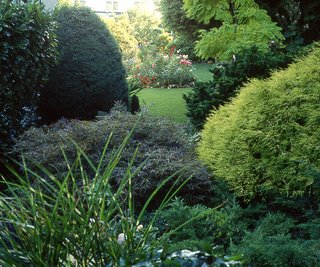Giboshi Man - Wolfram George Schmid
Sunday, July 09, 2006


I first met W. George Schmid at the American Hosta Socieity's National Convention in Columbus, Ohio in 1992. At first I was afraid of approaching the tiny and short man with the large glasses and the strange German/Southern accent. But I soon learned that he was one of the friendliest of the hosta gurus in attendance. He told me that he was an engineer who had designed rocket launching platforms for NASA. When moved to Atlanta in the 60s he was confronted with one of his toughest "technical" problems. He seemed to be unable to grow anything in his red Atlanta clay garden. This was the case until he bought some Hosta 'Honeybells'. This is an ordinary (but has fragrant flowers) hosta of no particular merit except that it grew well in red clay. Schmid was hooked. He researched the plants for 15 years and realizing that most of them (the Giboshi as hosta are called)came from Japan he learned Japanese. In 1991 he published the ultimate book on hosta, The Genus Hosta.
Schmid represents a lonely faction within the American Hosta Society. He loves green plants and thinks that the multi-variegated forms are difficult to place in a garden. These plants often revert to green and he calls them "dishonest" as oposed to his "green" friends.
Because of his knowledge in all things hosta Schmid is in charge of Nomenclature (with a capital N!). He speaks with such precision that I would love to see him dressed up as the Swedish Linnaeus who invented the system.
But as technical and precise as this man is he has taught me much that has to do with the design of a garden. Once he confessed to me that he talked to his plants, I didn't feel so embarrased that I did, too. His concept of "shoulder to shoulder" gardening, in which individual plants compete for space so that by the end of May I cannot see a square inch of dirt in my flower beds, is pure Schmid. It was Schmid who pointed out (it wasn't obvious to me then) that by placing a "blue" hosta next to a "gold" hosta the gold and blue plants would each be more intense in their colour. My Argentine painter friend, Juan Manuel Sanchez was almost speechless when I told him. "You mean you didn't know this? " He further advised me to bring in a third colour purple.
But Schmid's influence and legacy is increasing in my garden as I eschew bold hostas and select plants with that infinite variety of green that calms the nerves and brings peace to the soul.






